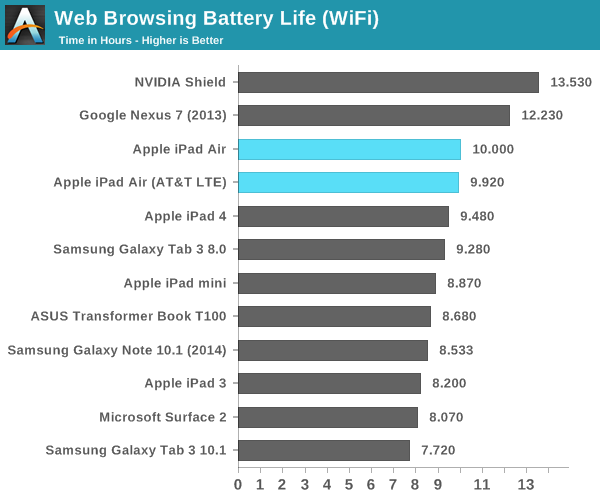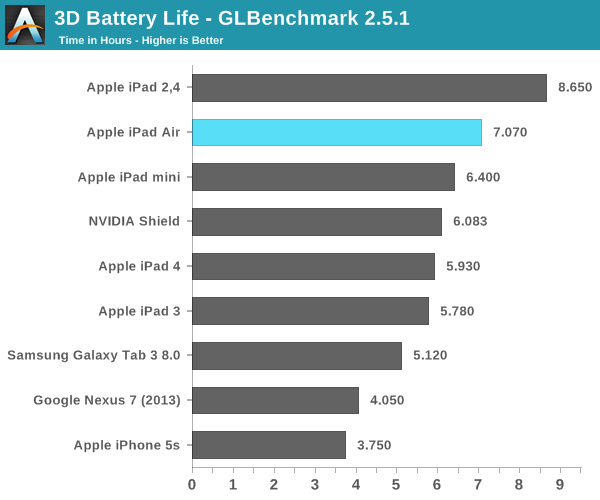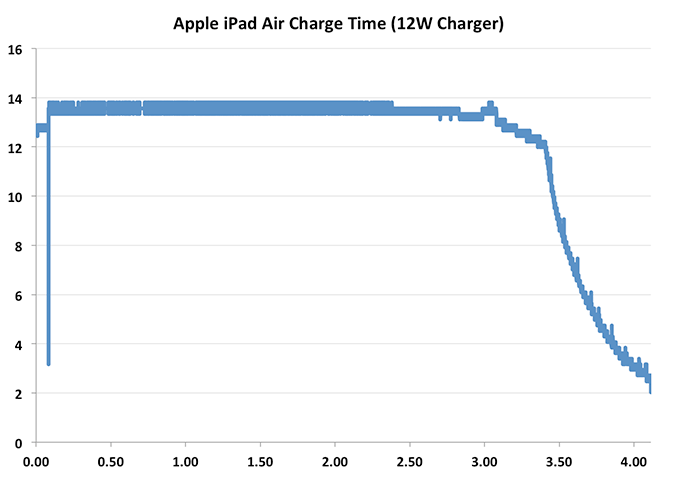The iPad Air Review
by Anand Lal Shimpi on October 29, 2013 9:00 PM ESTBattery Life
With the iPad Air Apple moved to a 32.4Wh battery, a significant decrease from the 42.5Wh unit in the 3rd and 4th generation iPads. The smaller battery doesn’t come with a change to Apple’s claim of 10 hours of battery life, which implies a reduction in overall platform power. I confirmed a substantial reduction in platform power in my crude measurements earlier in the article. Although it’s possible for the iPad Air to draw substantially more power than the iPad 4, our earlier power data seems to imply that it’s unlikely given the same exact workload. Our battery life tests agree.
We'll start with our 2013 smartphone/tablet web browsing battery life test. As always all displays are calibrated to 200 nits. The workload itself is hidden from OEMs to avoid any intentional gaming, but I've described it at a high level here.

Our web browsing workload came in at exactly 10 hours of continuous usage - an improvement compared to the iPad 4. Battery life on LTE was good as well, consistently delivering just under 10 hours of usage. The fact that both LTE and WiFi tests deliver similar results tells me that we may be bottlenecked by some other component in the system (perhaps display?).
I've been running the same video playback test for a while now, although we're quickly approaching a point where I'll need to move to a higher bitrate 1080p test. Here I'm playing a 4Mbps H.264 High Profile 720p rip I made of the Harry Potter 8 Blu-ray. The full movie plays through and is looped until the battery dies. Once again, the displays are calibrated to 200 nits:

Video playback battery life also improves slightly compared to the iPad 4. Apple’s battery life claims aren’t usually based around video playback, so exceeding their 10 hour suggestion here shouldn’t come as a shock. Apple’s video decode power has always been extremely low.
Our final cross-platform battery life test is based on Kishonti's Egypt HD test. Here we have a loop of the Egypt HD benchmark, capped to 30 fps, running on all of the devices with their screens calibrated to 200 nits.

Our 3D battery life rundown test shows a substantial improvement in battery life over the iPad 4. IMG’s PowerVR G6430, running a moderate workload, can do so more efficiently than any of the previous generation GPUs in Apple’s SoCs. Much like the A7’s CPU cores however, there’s a wider dynamic range of power consumption with the G6430. Running at max performance I would expect to see greater GPU power consumption. The question then becomes what’s more likely? Since the majority of iOS games don’t target the A7 (and instead shoot for lower end hardware), I would expect you to see better battery life even while gaming on the iPad Air vs the iPad 3/4.
Charge Time
The iPad Air comes with the same 12W USB charger and Lightning cable that we first saw with the iPad 4. Having to only charge a 32.5W battery means that charge times are lower compared to the iPad 3 and 4:

A full charge takes a little over 4 hours to complete. The adapter delivers as much as 12W to the iPad, drawing a maximum of 13.5W at the wall. I still think the sweet spot is somewhere closer to 2.5 hours but that’s another balancing game that must be played between charge time and maintaining battery health. It’s still so much better than the ~6 hours of charge time for the iPad 3 and 5.69 hours for the iPad 4.











444 Comments
View All Comments
solipsism - Wednesday, October 30, 2013 - link
Braumin, try to pay attention as this is simple economics. Apple sets their profit margin average. If you take that away from the higher-end then they ill make that up which means the other end from which you and BillBear claim *should* happen. That means, to follow your $10-15 difference between 16GB you would need to start at a much higher price.This is all before you consider what such a small price disparity would do to the sales of the other items. You really need to consider how Apple will make the same profit margin and overall net profit for the iPad category if the 128GB is now only in the $5xx range. This isn't rocket science.
BillBear - Thursday, October 31, 2013 - link
Nobody is claiming Apple isn't entitled to a profit.However, charging 100 dollars for something that costs them less than 15 dollars is obscene, no matter how you try to spin it.
I seriously cannot believe people are willing to get so derpy defending a 666% markup.
Is it just for Halloween?
solipsism - Saturday, November 2, 2013 - link
BillBear wrote, "I seriously cannot believe people are willing to get so derpy defending a 666% markup."I'm defending a free market system. If I don't like what Apple charges I don't buy it. It's really that simple. Your entitlement is sickening and your presumption of net component costs is grossly inaccurate.
ssiu wrote, "It could be something more proportional like
16GB $499
32GB $549
64GB $639
128GB $799
I would've gotten a 32GB instead of 16GB iPad 4 last year with a more reasonable price structure like that. Apple would've made more profit from me, and I would have better satisfaction."
You don't know what profit they would have made off you all you know is what revenue they would have earned off you. They are very different.
Again, you would have jumped to the 32GB model because the difference in price was halved. Do you not see how this can be a tactic disadvantage to a company trying to profit from that same capacity at $599? Do you not see how you might think Apple is getting more money is in fact $50 less per person that would have bought the 32GB model, regardless, which could lead to dramatically less profit? Do you not see how it could bump a huge number of people to double their NAND capacity which Apple might not be able to get enough of if the prices are too low and the demand for higher capacity is too high?
It's fine that you two want things to be less expensive and offer more features and options yada yada yada. We all do! But most people I encounter have at least a rudimentary understanding of supply and demand, and the complexities in designing price points that will maximize profits. Why even say it should ONLY $50 more or ONLY $15 more? Why not say they make enough profit on the other HW that they could should give me the capacity I want? One could certainly make that argument and based on their profit margins be completely accurate, but I do think you two have at least a little comprehension as to why that isn't a sound business decision as very few people would choose the 16GB over the 128GB version.
ssiu - Wednesday, October 30, 2013 - link
It could be something more proportional like16GB $499
32GB $549
64GB $639
128GB $799
I would've gotten a 32GB instead of 16GB iPad 4 last year with a more reasonable price structure like that. Apple would've made more profit from me, and I would have better satisfaction.
tgibbs - Wednesday, October 30, 2013 - link
I don't get the point. For almost any electronics product you buy, the components are far cheaper than the finished, assembled product. But unless you are going to manufacture your own home-brew device, that's irrelevant.From a consumer point of view, the only valid question is whether the additional value for the consumer is concordant with the price. And considering how well the larger capacity devices are selling, the answer seems to be yes.
BillBear - Wednesday, October 30, 2013 - link
The point is that Apple is charging 100 dollars for components that add less than fifteen bucks to the build of materials for the device. That is an obscene profit margin.(iSuppli put the cost of both the RAM and 16 Gigs of Flash in the iPad mini at $15.50 last year.)
http://www.isuppli.com/Teardowns/News/Pages/Low-En...
solipsism - Wednesday, October 30, 2013 - link
Now you're quoting iSuppli? Seriously?!BillBear - Thursday, October 31, 2013 - link
Both iSuppli and Flash drives at retail agree. We're talking about components that cost less than fifteen dollars being sold for one hundred dollars.solipsism - Saturday, November 2, 2013 - link
All NAND are not created equal.I bet you are the guy that tried to convince people that a netbook was just as capable, if not better, than other laptops.
Spunjji - Tuesday, November 5, 2013 - link
No, they're not, but even the most expensive NAND does not cost what Apple are charging.